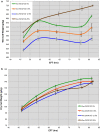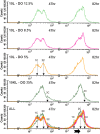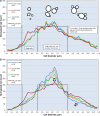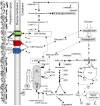Saccharomyces cerevisiae morphological changes and cytokinesis arrest elicited by hypoxia during scale-up for production of therapeutic recombinant proteins
- PMID: 30572885
- PMCID: PMC6300885
- DOI: 10.1186/s12934-018-1044-2
Saccharomyces cerevisiae morphological changes and cytokinesis arrest elicited by hypoxia during scale-up for production of therapeutic recombinant proteins
Abstract
Background: Scaling up of bioprocesses represents a crucial step in the industrial production of biologicals. However, our knowledge about the impact of scale-up on the organism's physiology and function is still incomplete. Our previous studies have suggested the existence of morphological changes during the scale-up of a yeast (Saccharomyces cerevisiae) fermentation process as inferred from the volume fraction occupied by yeast cells and exometabolomics analyses. In the current study, we noticed cell morphology changes during scale-up of a yeast fermentation process from bench (10 L) to industrial scale (10,000 L). We hypothesized that hypoxia observed during scale-up partially impaired the availability of N-acetyl-glucosamine, a precursor of chitin synthesis, a key polysaccharide component of yeast mother-daughter neck formation.
Results: Using a combination of flow cytometry with two high throughput cell imaging technologies, Vi-CELL and Flow Imaging, we found changes in the distribution of cell size and morphology as a function of process duration at the industrial scale of the production process. At the end of run, concomitantly with lowest levels of dissolved oxygen (DO), we detected an increase in cell subpopulations exhibiting low aspect ratio corresponding to morphologies exhibited by large-single-budded and multi-budded cells, reflecting incomplete cytokinesis at the M phase of the yeast mitotic cycle. Metabolomics from the intracellular milieu pointed to an impaired supply of precursors for chitin biosynthesis likely affecting the septum formation between mother and daughter and cytokinesis. Inducing hypoxia at the 10 L bench scale by varying DO levels, confirmed the existence and impact of hypoxic conditions on yeast cell size and morphology observed at the industrial scale.
Conclusions: We conclude that the observed increments in wet cell weight at the industrial scale correspond to morphological changes characterized by the large diameter and low aspect ratio exhibited by cell subpopulations comprising large single-budded and multi-budded cells. These changes are consistent with impairment of cytokinesis triggered by hypoxia as indicated by experiments mimicking this condition at DO 5% and 10 L scale. Mechanistically, hypoxia impairs N-acetyl-glucosamine availability, a key precursor of chitin synthesis.
Keywords: Cell wall; Cytokinesis; Fermentation bioprocess; Hypoxia; Metabolomics; Mitosis; Saccharomyces cerevisiae; Scale-up.
Figures








Similar articles
-
Hypoxia-elicited impairment of cell wall integrity, glycosylation precursor synthesis, and growth in scaled-up high-cell density fed-batch cultures of Saccharomyces cerevisiae.Microb Cell Fact. 2016 Aug 15;15(1):142. doi: 10.1186/s12934-016-0542-3. Microb Cell Fact. 2016. PMID: 27527078 Free PMC article.
-
Exometabolome analysis reveals hypoxia at the up-scaling of a Saccharomyces cerevisiae high-cell density fed-batch biopharmaceutical process.Microb Cell Fact. 2014 Mar 5;13(1):32. doi: 10.1186/1475-2859-13-32. Microb Cell Fact. 2014. PMID: 24593159 Free PMC article.
-
Saccharomyces cerevisiae Bni4p directs the formation of the chitin ring and also participates in the correct assembly of the septum structure.Microbiology (Reading). 2004 Oct;150(Pt 10):3229-41. doi: 10.1099/mic.0.27352-0. Microbiology (Reading). 2004. PMID: 15470103
-
Regulation of Mitotic Exit in Saccharomyces cerevisiae.Methods Mol Biol. 2017;1505:3-17. doi: 10.1007/978-1-4939-6502-1_1. Methods Mol Biol. 2017. PMID: 27826852 Review.
-
Engineering Saccharomyces cerevisiae for direct conversion of raw, uncooked or granular starch to ethanol.Crit Rev Biotechnol. 2015;35(3):369-91. doi: 10.3109/07388551.2014.888048. Crit Rev Biotechnol. 2015. PMID: 24666118 Review.
Cited by
-
Influence of microbial cell morphology and composition on radio frequency heating of simple media at different frequencies.Sci Rep. 2023 Jul 5;13(1):10839. doi: 10.1038/s41598-023-35705-4. Sci Rep. 2023. PMID: 37407624 Free PMC article.
-
Emergence of Phenotypically Distinct Subpopulations Is a Factor in Adaptation of Recombinant Saccharomyces cerevisiae under Glucose-Limited Conditions.Appl Environ Microbiol. 2022 Apr 12;88(7):e0230721. doi: 10.1128/aem.02307-21. Epub 2022 Mar 17. Appl Environ Microbiol. 2022. PMID: 35297727 Free PMC article.
-
Phenotypic and genotypic characterisation of Lactobacillus and yeast isolates from a traditional New Zealand Māori potato starter culture.Curr Res Food Sci. 2022 Aug 19;5:1287-1294. doi: 10.1016/j.crfs.2022.08.004. eCollection 2022. Curr Res Food Sci. 2022. PMID: 36061410 Free PMC article.
-
Influence of Microalgal Cell Division Tendency on OD to DCW Conversion Factor and Chlorophyll Contents.J Microbiol Biotechnol. 2025 Apr 9;35:e2412049. doi: 10.4014/jmb.2412.12049. J Microbiol Biotechnol. 2025. PMID: 40223249 Free PMC article.
References
-
- Aon JC, Sun J, Leighton J, Appelbaum E. Hypoxia-elicited impairment of cell wall integrity, glycosylation precursors synthesis, and growth in scaled-up high-cell density fed-batch cultures of Saccharomyces cerevisiae. Microb Cell Fact. 2016;15:142. doi: 10.1186/s12934-016-0542-3. - DOI - PMC - PubMed
MeSH terms
Substances
LinkOut - more resources
Full Text Sources
Molecular Biology Databases

